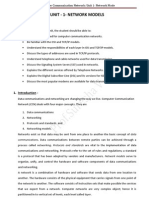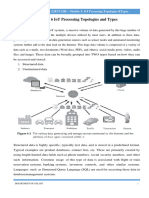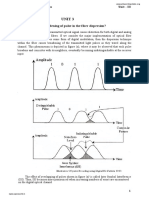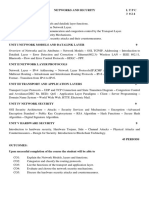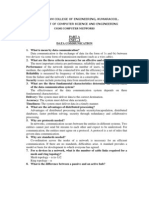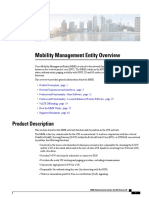CN PPT-Unit I
CN PPT-Unit I
Uploaded by
Sashikanth BethaCopyright:
Available Formats
CN PPT-Unit I
CN PPT-Unit I
Uploaded by
Sashikanth BethaCopyright
Available Formats
Share this document
Did you find this document useful?
Is this content inappropriate?
Copyright:
Available Formats
CN PPT-Unit I
CN PPT-Unit I
Uploaded by
Sashikanth BethaCopyright:
Available Formats
COMPUTER NETWORKS
Presented By
Mr. B.Sashi Kanth
Assistant Professor
Department of ECE
Vignan’s Institute of Engineering for Women
Affiliated to JNTUK
Visakhapatnam, Andhra Pradesh.
Department of Electronics and Communication Engineering
Vignan’s Institute of Engineering for Women, Visakhapatnam
Overview about Units in Computer Networks
Department of Electronics and Communication Engineering 2
Vignan’s Institute of Engineering for Women, Visakhapatnam
Basics of Computer Networks
UNIT-I Network Criteria Issues
Introduction to Computer Network Topologies
Networks OSI Reference Model
TCP/IP Model
UNIT-II Bandwidth limited signals
Physical Layer Guided Transmission Media
& Digital modulation
Data Link Layer FDM, TDM CDM
Data link layer design Issues
Error Detection and Correction
Data link Protocols
Sliding Window Protocol
Department of Electronics and Communication Engineering 3
Vignan’s Institute of Engineering for Women, Visakhapatnam
UNIT-III Framing
Services provided to network Error Correcting and detecting
layer codes
Simplex stop and wait protocol
Simplex stop and wait protocol
with noisy channel
One-bit sliding window protocol
UNIT-IV Static Channel Allocation
Medium Access Control Sub- Dynamic Channel Allocation
Layer ALOHA
Wireless LAN Protocols
MAC Sub layer Protocols
Ethernet Performance
802.11 Architecture and Protocol
805.11 Frame Structure
Department of Electronics and Communication Engineering 4
Vignan’s Institute of Engineering for Women, Visakhapatnam
UNIT-V Store and forward packet
Network Design Issues switching
Transport layer connectionless
and connection-oriented
Routing algorithms
Congestion Control algorithm
Traffic throttling & Load shedding
UNIT-VI
Internet Transport Protocols
UDP
&
TCP
Application Layer
DNS
Resource Records
E-Mail Architecture and Services
Message Format and transfer
Final Delivery of E-Mail
Department of Electronics and Communication Engineering 5
Vignan’s Institute of Engineering for Women, Visakhapatnam
Department of Electronics and Communication Engineering 6
Vignan’s Institute of Engineering for Women, Visakhapatnam
CONTENTS
Definition of Computer Networks
Data Communication system &Components of Comm. system
Data Respresentation
Data Flow in different ways.
Network Criteria.
Type of Connections.
Topology and Different types of Topology.
Categories of Networks.
Internet Service Providers
OSI Reference Model
TCP/IP Model
Department of Electronics and Communication Engineering 7
Vignan’s Institute of Engineering for Women, Visakhapatnam
What is Computer Networks?
• A computer network is a set of devices connected through
links. A node can be computer, printer, or any other device
capable of sending or receiving the data. The links connecting
the nodes are known as communication channels.
Fig 1: Computer Network Connection
Department of Electronics and Communication Engineering 8
Vignan’s Institute of Engineering for Women, Visakhapatnam
Data Communication System
• What is Data Communication system?
Fig 2: Data Communication System
Components of Data Communication
1. Message
2. Sender
3. Receiver
4. Transmission Media
5. Protocol
Department of Electronics and Communication Engineering 9
Vignan’s Institute of Engineering for Women, Visakhapatnam
Data Representation can be different ways i.e. Text, numbers,
images, audio and video format.
Dataflow representation can be different ways.
1. Simplex
2. Half-Duplex
3. Full Duplex
Fig 3: Dataflow communication system
Department of Electronics and Communication Engineering 10
Vignan’s Institute of Engineering for Women, Visakhapatnam
What is Network?
• A network is a set of devices (often referred to as nodes) connected
by communication links. A node can be a computer, printer, or any
other device capable of sending and/or receiving data generated by
other nodes on the network.
• Network Criteria is able to meet some issues like…
Performance Transit time & Response time
Reliability Accuracy of delivery & Recovery of link Failures.
Security Protecting data from Unauthorized access and
implementing policies & Procedures.
Table 1: Network Criteria Issues
Department of Electronics and Communication Engineering 11
Vignan’s Institute of Engineering for Women, Visakhapatnam
Types of Connections
• A network is two or more devices connected through links. A
link is a communications pathway that transfers data from one
device to another.
Point to Point Connection.
Multi-point Connection.
Fig 4: Types of Connections
Department of Electronics and Communication Engineering 12
Vignan’s Institute of Engineering for Women, Visakhapatnam
What is Topology?
• Topology means the manner in which nodes are geometrically
arranged and connected is known as the Topology of the
network. (or) Two or more devices connect to a link; two or
more links form a topology.
Topology are two types:-
1. Physical Topology
2 . Logical Topology.
Physical Topology : It refers to network interconnection in
physical manner actually in wire or transmission media.
Logical Topology : It defines how the host access media to send
data.
Department of Electronics and Communication Engineering 13
Vignan’s Institute of Engineering for Women, Visakhapatnam
Logical Topology
Fig 5: Logical Topology Connections
Department of Electronics and Communication Engineering 14
Vignan’s Institute of Engineering for Women, Visakhapatnam
Bus Topology
• Bus Topology also called horizontal topology.
• A networking topology that connects networking components
along a single cable or that uses a series of cable segments that
are connected linearly. A network that uses a bus topology is
referred to as a “bus network.”
Fig 6: Bus Topology
Department of Electronics and Communication Engineering 15
Vignan’s Institute of Engineering for Women, Visakhapatnam
• Advantages
Easy to use and easy to install.
Costs are usually low
Easy to add systems to network
Great for small networks.
A repeater can also be used to extend a bus topology network.
• Disadvantages
Heavy network traffic can slow a bus considerably.
Failure a cable affects all devices on the network.
It is difficult to troubleshoot a bus.
Unmanageable in a large network
If cable breaks, whole network is down
Department of Electronics and Communication Engineering 16
Vignan’s Institute of Engineering for Women, Visakhapatnam
Ring Topology
• In a ring topology, each device has a dedicated point-to-point
connection with only the two devices on either side of it. A
signal is passed along the ring in one direction, from device to
device, until it reaches its destination.
Fig 7: Ring Topology
• Each device in the ring incorporates a repeater.
Department of Electronics and Communication Engineering 17
Vignan’s Institute of Engineering for Women, Visakhapatnam
• Advantages:
Easy to install.
Easy to reconfigure.
Fault identification is easy.
• Disadvantage:
Unidirectional traffic.
Break in a single ring can break entire network.
Adding or removing nodes disrupts the network.
It is difficult to troubleshoot a ring network.
Much slower than an Ethernet network under normal load.
Cost of cable is more in ring network.
Department of Electronics and Communication Engineering 18
Vignan’s Institute of Engineering for Women, Visakhapatnam
Mesh Topology
• In a mesh topology, every device has a dedicated point-to-point
link to every other device. The term dedicated means that the
link carries traffic only between the two devices it connects. To
connect n nodes in Mesh topology, we require n(n-1)/2 duplex
mode links.
Fig 8: Mesh Topology
Department of Electronics and Communication Engineering 19
Vignan’s Institute of Engineering for Women, Visakhapatnam
• Advantages:
Troubleshooting is easy.
Robust, If one link becomes unusable, it does not incapacitate
the entire system.
Advantage of privacy or security.
fault identification and fault isolation easy , Traffic can be
routed to avoid links with suspected problems.
• Disadvantage:
Required high amount of cabling and the number of I/O ports.
Costly because of maintaining redundant links.
Difficulty of reconfiguration.
Department of Electronics and Communication Engineering 20
Vignan’s Institute of Engineering for Women, Visakhapatnam
Problem for Mesh Topology
1. A mesh network has 8 devices. Calculate total
number of cable links and IO ports needed.
Solution:
Number of devices = 8
Number of links = n (n-1)/2
8(8-1)/2 = 28
Number of port/device = n-1 = 8-1 = 7
Department of Electronics and Communication Engineering 21
Vignan’s Institute of Engineering for Women, Visakhapatnam
Star Topology
• In a star topology, each device has a dedicated point-to-point link
only to a central controller, usually called a hub. The devices are
not directly linked to one another.
• The controller acts as an exchange: If one device wants to send data
to another, it sends the data to the controller, which then relays the
data to the other connected device.
Fig 9 : Star Topology
Department of Electronics and Communication Engineering 22
Vignan’s Institute of Engineering for Women, Visakhapatnam
• Advantages:
Less Expensive than mesh topology.
Installation and configuration are easy.
Less cabling is need then mesh.
Robustness.
Easy to fault identification & isolation.
• Disadvantage:
If the central hub fails, the whole network fails to operate.
Each device requires its own cable segment.
Installation can be moderately difficult.
Department of Electronics and Communication Engineering 23
Vignan’s Institute of Engineering for Women, Visakhapatnam
Hybrid Topology
• It is two different types of topologies which is a mixture of
two or more topologies. For example if in an office in one
department ring topology is used and in another star topology
is used, connecting these topologies will result in Hybrid
Topology (ring topology and star topology).
Fig 10: Hybrid Topology
Department of Electronics and Communication Engineering 24
Vignan’s Institute of Engineering for Women, Visakhapatnam
• Advantages
Reliable as Error detecting and trouble shooting is easy.
Effective.
Scalable as size can be increased easily.
Flexible.
• Disadvantage
Complex in design.
Costly.
Department of Electronics and Communication Engineering 25
Vignan’s Institute of Engineering for Women, Visakhapatnam
Categories of Networks
• 1. Local Area Network (LAN)
• 2. Metropolitan Area Network (MAN)
• 3. Wide Area Network (WAN)
Department of Electronics and Communication Engineering 26
Vignan’s Institute of Engineering for Women, Visakhapatnam
Local Area Network (LAN)
• Local area networks, generally
called LANs, are privately-owned
networks within a single building or
campus of up to a few kilometres in
size.
• They are widely used to connect
personal computers and
workstations in company offices and
factories to share resources (e.g.,
printers) and exchange information.
• Traditional LANs run at speeds of
10 Mbps to 100 Mbps, have low
delay (microseconds or
nanoseconds), and make very few Fig 11: LAN Connection through Hub
errors.
Department of Electronics and Communication Engineering 27
Vignan’s Institute of Engineering for Women, Visakhapatnam
MAN (Metropolitan Area Network)
• MAN is a network that spans a
city. The network consists of
various buildings interconnected
Via either wireless or fiber
optics backbones.
• A metropolitan area
network(MAN) is a large
computer network that usually
spans a city or a large campus.
The best-known example of a
MAN is the cable television
network available in many cities.
• MAN provides the transfer rates
Fig 12: Metropolitan Area Network
from 34 to 150 Mbps.
Department of Electronics and Communication Engineering 28
Vignan’s Institute of Engineering for Women, Visakhapatnam
WAN (Wide Area Network)
• A network that spans
broader geographical area
than a local area network
over public communication
network. WANs
interconnect LANs, which
then provide access to
computers or file servers in
other locations.
• WANs provide instant
communications across
large geographic areas. Fig 13: Relation between hosts on LAN
and subnet
Department of Electronics and Communication Engineering 29
Vignan’s Institute of Engineering for Women, Visakhapatnam
Internet Service Providers (ISPs)
1. International Internet
Service Providers.
2. National Internet Service
Providers
3. Regional Internet Service
Providers
Fig 14: Internet Service Providers (ISPs)
Department of Electronics and Communication Engineering 30
Vignan’s Institute of Engineering for Women, Visakhapatnam
Protocols and Standards
• A protocol is a set of rules that govern data communications. A
protocol defines what is communicated, how it is
communicated, and when it is communicated. The key
elements of a protocol are syntax, semantics, and timing.
Syntax.
Semantics.
Timing.
Department of Electronics and Communication Engineering 31
Vignan’s Institute of Engineering for Women, Visakhapatnam
LAYERED TASKS
Fig 15: Layered Task
Department of Electronics and Communication Engineering 32
Vignan’s Institute of Engineering for Women, Visakhapatnam
• Layers can offer two different types of service to the layers:
connection-oriented and connectionless.
Fig 16: Five service primitives for implementing a simple connection-oriented
service.
Department of Electronics and Communication Engineering 33
Vignan’s Institute of Engineering for Women, Visakhapatnam
OSI REFERENCE MODEL
• This model is based on a proposal developed by the
International Standards Organization (ISO) as a first step
toward international standardization of the protocols used in
the various layers .
• The model is called the ISO-OSI (Open Systems
Interconnection).
Department of Electronics and Communication Engineering 34
Vignan’s Institute of Engineering for Women, Visakhapatnam
OSI Reference Model Seven layers
Department of Electronics and Communication Engineering 35
Vignan’s Institute of Engineering for Women, Visakhapatnam
Inter Connection between layers
Department of Electronics and Communication Engineering 36
Vignan’s Institute of Engineering for Women, Visakhapatnam
The interaction between layers in the OSI model
Department of Electronics and Communication Engineering 37
Vignan’s Institute of Engineering for Women, Visakhapatnam
OSI MODEL EXCHANGE DATA
Department of Electronics and Communication Engineering 38
Vignan’s Institute of Engineering for Women, Visakhapatnam
Physical Layer
Physical layer is the bottom layer of the OSI reference
model.
The physical layer is concerned with transmitting raw bits
over a communication channel. The design issues have to do
with making sure that when one side sends a 1 bit, it is
received by the other side as a 1 bit, not as a 0 bit.
Department of Electronics and Communication Engineering 39
Vignan’s Institute of Engineering for Women, Visakhapatnam
Physical Layer
To transmit the stream of bits they must be encoded into
signal.
The sender and receiver not only must use the same bit
rate but also must be synchronized at the bit level.
In the physical layer the devices can be connected to point- to-
point connection or multi-point connection
The physical layer data transmission can be any different ways
i.e. simplex, half-duplex and full-duplex.
Department of Electronics and Communication Engineering 40
Vignan’s Institute of Engineering for Women, Visakhapatnam
Data-Link Layer
Data Link Layer is divided into two sub-ways i.e.
The LLC layer is responsible for flow control, error correction and
resequencing of information in connection-oriented and
connectionless services.
The MAC Layer is responsible for providing gain access to the
medium.
Department of Electronics and Communication Engineering 41
Vignan’s Institute of Engineering for Women, Visakhapatnam
Data-Link Layer
The data link layer divides the stream of bits received from the
network layer into manageable data units called frames.
the data link layer adds a header to the frame to define the
sender and/or receiver of the frame.
Department of Electronics and Communication Engineering 42
Vignan’s Institute of Engineering for Women, Visakhapatnam
Data-Link Layer
Flow Control:
If the rate at which the data are absorbed by the receiver is less
than the rate at which data are produced in the sender, the data
link layer imposes a flow control mechanism to avoid
overwhelming the receiver.
Error Control:
To improve the reliability the Datalink layer adds a trailer which
contains the error control mechanism like CRC, Checksum etc.
Access control:
When two or more devices are connected to the same link, data
link layer protocols are necessary to determine which device has
control over the link at any given time.
Department of Electronics and Communication Engineering 43
Vignan’s Institute of Engineering for Women, Visakhapatnam
Network Layer
Network Layer key design issue how to route packets format
(Data) from source to destination.
Network layer is responsible for functions of:
I. Logical addressing and routing of packets over the
network.
II. Establishing and releasing connections and paths
between two nodes on a network.
III. Transferring data, generating and confirming
receipts, and resetting connections.
Department of Electronics and Communication Engineering 44
Vignan’s Institute of Engineering for Women, Visakhapatnam
Network Layer
Logical addressing:
Data link layer implements physical addressing. When a packet
passes network boundary, an addressing system is needed to
distinguish source and destination, network layer performs these
functions. The network layer adds a header to the packet of upper
layer includes the logical addresses of sender and receiver.
The network layer also supplies connectionless and connection-
oriented services to the transport layer above it.
Department of Electronics and Communication Engineering 45
Vignan’s Institute of Engineering for Women, Visakhapatnam
Transport layer
The transport layer is responsible for providing reliable
transport services to the upper-layer protocols.
Flow control to ensure that the transmitting device does
not send more data than the receiving device can handle.
Department of Electronics and Communication Engineering 46
Vignan’s Institute of Engineering for Women, Visakhapatnam
Transport Layer
• Segmentation and reassembly.
– A message is divided into manageable units called as
segments.
– Each segment is reassembled after received that
information at the receiver end.
– To make this efficient each segment contains a sequence
number.
• Error handling and acknowledgments to ensure that data is
retransmitted when required.
• Multiplexing for combining data from several sources for
transmission over one data path.
Department of Electronics and Communication Engineering 47
Vignan’s Institute of Engineering for Women, Visakhapatnam
Session Layer
• The session layer allows users which enables sessions
between computers on a network to be established
and terminated.
Department of Electronics and Communication Engineering 48
Vignan’s Institute of Engineering for Women, Visakhapatnam
Session Layer
– Dialog control: The session layer allows two systems to
enter into a dialog. It allows the communication between
two processes to take place in either half- duplex (one way
at a time) or full-duplex (two ways at a time) mode.
– Token management: preventing two parties from
attempting the same critical operation at the same time.
– Synchronization: The session layer allows a process to
add checkpoints, or synchronization points, to a stream of
data. Check pointing long transmissions to allow them to
continue from where they were after a crash.
Department of Electronics and Communication Engineering 49
Vignan’s Institute of Engineering for Women, Visakhapatnam
Presentation Layer
• The presentation layer is concerned with the syntax and
semantics of the information exchanged between two systems.
• Specific responsibilities of layer:
Translation
Encryption
Compression
Department of Electronics and Communication Engineering 50
Vignan’s Institute of Engineering for Women, Visakhapatnam
Application Layer
The application layer contains a variety of protocols that are
commonly needed by users.
One widely-used application protocol is HTTP (Hypertext
Transfer Protocol), which is the basis for the World Wide Web.
Department of Electronics and Communication Engineering 51
Vignan’s Institute of Engineering for Women, Visakhapatnam
Application Layer
• Network Virtual Terminal: It is a software version of a
physical terminal and allows a user to log on to a remote host.
• File Transfer, Access, and Management:
• It allows a user to access files in a remote computer, retrieve
files, and manage or control files in a remote computer.
• Mail Services: It provides the basis for e-mail forwarding and
storage.
• Directory Services: It provides distributed database sources
and access for global information about various objects and
services
Department of Electronics and Communication Engineering 52
Vignan’s Institute of Engineering for Women, Visakhapatnam
TCP/IP Reference Model
Host-to-Network Layer
Internet Layer
Transport Layer
Application Layer
Department of Electronics and Communication Engineering 53
Vignan’s Institute of Engineering for Women, Visakhapatnam
HOST-TO-NETWORK LAYER:
• At the physical and data link layers, TCPIIP does not define
any specific protocol. It supports all the standard and
proprietary protocols. A network in a TCPIIP internetwork
can be a local-area network or a wide-area network.
INTERNET LAYER:
• At the network layer (or, more accurately, the internetwork
layer), TCP/IP supports the Internetworking Protocol. IP, in
turn, uses four supporting protocols: ARP,RARP, ICMP, and
IGMP.
• Internetworking Protocol (IP): The Internetworking
Protocol (IP) is the transmission mechanism used by the
TCP/IP protocols. It is an unreliable and connectionless
protocol-a best-effort delivery service.
Department of Electronics and Communication Engineering 54
Vignan’s Institute of Engineering for Women, Visakhapatnam
TCP/IP Protocol
• Address Resolution Protocol: The (ARP) is used to
determine the physical address when logical address is known.
• Reverse Address Resolution Protocol: The (RARP) is used
to determine the logical address when physical address is
known.
• Internet Control Message Protocol: The (ICMP) is a
protocol that is used to control the flow of message over
transmission medium by sending notification messages to the
sender.
• Internet Group Message Protocol: The(IGMP) is used to
facilitate the simultaneous transmission of a message to a
group of recipients.
Department of Electronics and Communication Engineering 55
Vignan’s Institute of Engineering for Women, Visakhapatnam
• TCP is a reliable stream transport protocol. The term stream,
in this context, means connection-oriented.
– User Datagram Protocol: UDP is the simpler of the two
standard TCP/IP transport protocols. It is a process-to-
process protocol that adds only port addresses, checksum
error control, and length information to the data from the
upper layer.
– Stream Control Transmission Protocol: The SCTP
provides support for newer applications such as voice over
the Internet. It is a transport layer protocol that combines
the best features of UDP and TCP.
Department of Electronics and Communication Engineering 56
Vignan’s Institute of Engineering for Women, Visakhapatnam
THE APPLICATION LAYER:
– The TCP/IP model does not have session or presentation layers. On top of the
transport layer is the application layer.
– It contains all the higher-level protocols. The early ones included virtual terminal
(TELNET), file transfer (FTP), and electronic mail (SMTP)
– The virtual terminal protocol allows a user on one machine to log onto a distant
machine and work there.
– The file transfer protocol provides a way to move data efficiently from one machine
to another.
– Electronic mail was originally just a kind of file transfer, but later a specialized
protocol (SMTP) was developed for it.
– Many other protocols have been added to these over the years: the Domain Name
System (DNS)
Department of Electronics and Communication Engineering 57
Vignan’s Institute of Engineering for Women, Visakhapatnam
Conclusion
Definition of Computer Networks is known.
Data Communication system &Components of Comm. system
Data Respresentation
Data Flow in different ways is known.
Network Criteria is known.
Type of Connections is explained.
Topology and Different types of Topology is seen.
Categories of Networks is explained.
Internet Service Providers
OSI Reference Model with diagrams is explained
TCP/IP Model is explained.
Department of Electronics and Communication Engineering 58
Vignan’s Institute of Engineering for Women, Visakhapatnam
Assignment Questions
1. What is layered architecture? Explain its design issue?
2. Describe the network types, topologies and switching
methods.
3. Compare the OSI and TCP/IP reference model.
4. Explain OSI reference model, with neat sketch.
Department of Electronics and Communication Engineering 59
Vignan’s Institute of Engineering for Women, Visakhapatnam
FAQs – Short Answers
1. What is the significance of layered architecture?
2. What is point-to-point link transmission?
3. What are the responsibilities of physical layer?
4. Explain in detail about the MAN.
5. What is the difference between LAN and WAN?
6. List and explain the five components of a data
communication system.
Department of Electronics and Communication Engineering 60
Vignan’s Institute of Engineering for Women, Visakhapatnam
FAQs – Long Answers
1. What is layered architecture? Explain its design issue?
2. Describe the network types.
3. Compare the OSI and TCP/IP reference model.
4. Explain OSI reference model, with neat sketch.
5. Explain about TCP/IP Model.
6. Explain different topologies models.
Department of Electronics and Communication Engineering 61
Vignan’s Institute of Engineering for Women, Visakhapatnam
Interactions
Department of Electronics and Communication Engineering 62
Vignan’s Institute of Engineering for Women, Visakhapatnam
THANK YOU
B.Sashi Kanth
Assistant Professor
Department of Electronics and Communication Engineering
Vignan’s Institute of Engineering for Women
Affiliated to JNTUK
Visakhapatnam,
Department of Electronics and Communication Andhra Pradesh.
Engineering 63
Vignan’s Institute of Engineering forEmail
Women, Visakhapatnam
ID: sashis2@gmail.com
You might also like
- SM-A145R Service Manual Block DiagramDocument5 pagesSM-A145R Service Manual Block DiagramMM-MobileNo ratings yet
- Ece403 - Itc - Unit 1 - PPT NotesDocument111 pagesEce403 - Itc - Unit 1 - PPT NotesSai CharanNo ratings yet
- A REPORT ON MIMO IN WIRELESS APPLICATIONS - FinalDocument11 pagesA REPORT ON MIMO IN WIRELESS APPLICATIONS - FinalBha RathNo ratings yet
- Fortigate Study Guide Page 237: "By Default, Logs Older Than 7 Days Are Deleted From Disk (Log Age Is Configurable) "Document52 pagesFortigate Study Guide Page 237: "By Default, Logs Older Than 7 Days Are Deleted From Disk (Log Age Is Configurable) "Ra GeNo ratings yet
- Weidmueller Tech Note Turbo Ring V2 With Dual Ring 280411Document5 pagesWeidmueller Tech Note Turbo Ring V2 With Dual Ring 280411trung2iNo ratings yet
- CCN Notes For Unit 1. VTU Students. Prof - Suresha VDocument38 pagesCCN Notes For Unit 1. VTU Students. Prof - Suresha VSuresha V Sathegala85% (13)
- OverviewDocument2 pagesOverviewPavamana Giribhattanavar0% (1)
- EC8551 CN Question BankDocument43 pagesEC8551 CN Question BankRaja Pirian100% (3)
- LAN Protocol ArchitectureDocument27 pagesLAN Protocol ArchitectureMallikarjuna Naik100% (1)
- CN Unit-1 PPTDocument230 pagesCN Unit-1 PPTFjjdjrj djrjfjNo ratings yet
- 1.unit 1Document24 pages1.unit 1Ganesh VignaniNo ratings yet
- Chapter 9: Transport Layer and Security Protocols For Ad Hoc Wireless NetworksDocument85 pagesChapter 9: Transport Layer and Security Protocols For Ad Hoc Wireless NetworksZohaib Afridi100% (3)
- Module 5 CNDocument26 pagesModule 5 CNNadeem PashaNo ratings yet
- Wireless Telecommunications Systems & Networks: Gary J. MullettDocument56 pagesWireless Telecommunications Systems & Networks: Gary J. MullettVaishali Powar100% (1)
- Framing and MethodsDocument13 pagesFraming and Methodsarya_himanshi100% (1)
- Nptel: Implementation of Iot With Raspberry Pi: Part 2Document106 pagesNptel: Implementation of Iot With Raspberry Pi: Part 2Anakha VenugopalNo ratings yet
- EX of RSA AlgorithmDocument10 pagesEX of RSA AlgorithmMandira DasNo ratings yet
- Lec-13-Perceptron Vs Bayes ClassifierDocument12 pagesLec-13-Perceptron Vs Bayes ClassifiersadaqatsaghriNo ratings yet
- Design Goals of Transport Layer ProtocolDocument1 pageDesign Goals of Transport Layer ProtocolSwamy NallabelliNo ratings yet
- 2.4 Operating Systems and Execution EnvironmentsDocument12 pages2.4 Operating Systems and Execution EnvironmentssaravananNo ratings yet
- Cs9251 Mobile Computing Question BankDocument16 pagesCs9251 Mobile Computing Question BankNivithaNo ratings yet
- ME Anna University Report FormatDocument12 pagesME Anna University Report FormatAmal JithNo ratings yet
- 18EC743-MMC-Module-4 NotesDocument45 pages18EC743-MMC-Module-4 Notesmkhushim83100% (1)
- Course Name: ECPC24 Digital CommunicationDocument68 pagesCourse Name: ECPC24 Digital CommunicationNandini KumawatNo ratings yet
- UNIT-5: Task CommunicationDocument30 pagesUNIT-5: Task CommunicationFarheenNo ratings yet
- Unit 3Document51 pagesUnit 3Punitha BrawinNo ratings yet
- Unit 3 NotesDocument34 pagesUnit 3 NotesLavanya BasavarajNo ratings yet
- Adhoc Question Bank EC2050Document26 pagesAdhoc Question Bank EC2050amit0% (1)
- CN Unit 2 NotesDocument53 pagesCN Unit 2 NotesJashwanth REddyNo ratings yet
- AP5004-High Performance Networks - SyllabusDocument1 pageAP5004-High Performance Networks - Syllabusjames RNo ratings yet
- EC8093 Unit 5Document124 pagesEC8093 Unit 5Santhosh Pa100% (1)
- Module-3 IoT NotesDocument9 pagesModule-3 IoT NotesNeetha DasNo ratings yet
- Oral Question Bank CnsDocument9 pagesOral Question Bank CnsTera BhaiNo ratings yet
- Unit-4: Iot Architecture and ProtocolsDocument22 pagesUnit-4: Iot Architecture and ProtocolsMahesh ChauhanNo ratings yet
- AD3501 Deep Learning SyllabusDocument1 pageAD3501 Deep Learning SyllabusathirayanpericseNo ratings yet
- Module - 4: WDM Concepts and ComponentsDocument224 pagesModule - 4: WDM Concepts and ComponentsSourav B MNo ratings yet
- Unit I-IntroductionDocument23 pagesUnit I-IntroductionpadmapriyaNo ratings yet
- Digital Electronics and Microprocessor Lecture NotesDocument187 pagesDigital Electronics and Microprocessor Lecture Notes514 Vaibhavi PawarNo ratings yet
- Unit 3: Write Notes On Broadening of Pulse in The Fiber Dispersion?Document13 pagesUnit 3: Write Notes On Broadening of Pulse in The Fiber Dispersion?Md Minhaj Ahmed AhmedNo ratings yet
- Q4Document3 pagesQ4SkvkNo ratings yet
- Reflection Coefficients For Lattice RealizationDocument8 pagesReflection Coefficients For Lattice RealizationGirija VaniNo ratings yet
- Fiot Unit 2Document37 pagesFiot Unit 2Anusha Penchala100% (1)
- Network Node Architecture ForDocument7 pagesNetwork Node Architecture ForRavi AnnepakaNo ratings yet
- Chapter 18Document87 pagesChapter 18ZulaikhaEka100% (1)
- Embedded System 16 Marks University QuestionsDocument2 pagesEmbedded System 16 Marks University Questionsg3v5No ratings yet
- Computer Networks Course FileDocument50 pagesComputer Networks Course Filechaman suberNo ratings yet
- Question Paper Code:: Reg. No.Document2 pagesQuestion Paper Code:: Reg. No.methila100% (2)
- Switching TechniquesDocument14 pagesSwitching TechniquesKavya Parashar100% (1)
- Single-Node Architecture: Unit Ii ArchitecturesDocument40 pagesSingle-Node Architecture: Unit Ii Architecturessavsen6720No ratings yet
- 5 Years Anna University Question PaperDocument13 pages5 Years Anna University Question PaperG. SIVARANJANI Associate ProfessorNo ratings yet
- Advanced Arm Processors: Ch. S. V. Maruthi Rao Associate Professor Department of ECE, S. I. E. TDocument27 pagesAdvanced Arm Processors: Ch. S. V. Maruthi Rao Associate Professor Department of ECE, S. I. E. TMaruthi RaoNo ratings yet
- Embedded Systems: Technical PublicationsDocument16 pagesEmbedded Systems: Technical PublicationsPrince Scott100% (1)
- RMK Group A4 PPT - MPMC - Ec8691 - Unit 1Document127 pagesRMK Group A4 PPT - MPMC - Ec8691 - Unit 1Gowtham Reddy Rekkala100% (1)
- Ec3401 Networks and Security L T P CDocument2 pagesEc3401 Networks and Security L T P Cjames RNo ratings yet
- CN - 2 Marks Questions and SolutionsDocument23 pagesCN - 2 Marks Questions and Solutionsaccessgm100% (4)
- Lesson Plan - DPCODocument5 pagesLesson Plan - DPCOLaks SadeeshNo ratings yet
- CS3351 Dpco Lesson PlanDocument7 pagesCS3351 Dpco Lesson Planmagy1989No ratings yet
- CN PPT-Unit VIDocument29 pagesCN PPT-Unit VISashikanth BethaNo ratings yet
- Subband Coding: Presented by DR.R Murugan NIT SilcharDocument11 pagesSubband Coding: Presented by DR.R Murugan NIT SilcharR MuruganNo ratings yet
- Anchoring NetworkDocument12 pagesAnchoring NetworkSyed UmarNo ratings yet
- ARTIGO EN - Article - Instituto Politécnico de Beja, Escola Superior de Tecnologia e GestãoDocument5 pagesARTIGO EN - Article - Instituto Politécnico de Beja, Escola Superior de Tecnologia e GestãoJaejaneiro NtlNo ratings yet
- Chapter 6 - Network Concepts Technologies (VE)Document42 pagesChapter 6 - Network Concepts Technologies (VE)m.ahmeddx78No ratings yet
- Gtu PaperDocument4 pagesGtu Paperkaushal.21beect008No ratings yet
- A Unified Approach in Audio Signal ProcessingDocument5 pagesA Unified Approach in Audio Signal ProcessingSashikanth BethaNo ratings yet
- Advanced EDC & PDC NotesDocument19 pagesAdvanced EDC & PDC NotesSashikanth BethaNo ratings yet
- CN PPT-Unit VIDocument29 pagesCN PPT-Unit VISashikanth BethaNo ratings yet
- CN PPT-Unit IIIDocument59 pagesCN PPT-Unit IIISashikanth BethaNo ratings yet
- CN PPT-Unit IIDocument52 pagesCN PPT-Unit IISashikanth BethaNo ratings yet
- Indo - German Institute of Advanced Technology: Igiat PresentationDocument14 pagesIndo - German Institute of Advanced Technology: Igiat PresentationSashikanth BethaNo ratings yet
- Part 2 C Programming EssentialsDocument33 pagesPart 2 C Programming EssentialsSashikanth BethaNo ratings yet
- Part 3 C Peripheral InterfacesDocument27 pagesPart 3 C Peripheral InterfacesSashikanth BethaNo ratings yet
- Code Generation Tools FAQDocument11 pagesCode Generation Tools FAQSashikanth BethaNo ratings yet
- Part 1 PIC Microcontroller SystemsDocument30 pagesPart 1 PIC Microcontroller SystemsSashikanth BethaNo ratings yet
- Transmission LinesDocument33 pagesTransmission LinesNalini SivanesanNo ratings yet
- Digital Watermarking Using Wavelet TransformDocument1 pageDigital Watermarking Using Wavelet TransformSashikanth BethaNo ratings yet
- TI+Lab+2 Intro To Model Based Design With Simulink ManualDocument5 pagesTI+Lab+2 Intro To Model Based Design With Simulink ManualSashikanth BethaNo ratings yet
- Zigbee Based Indrustrial Security System: Bachelor of TechnologyDocument76 pagesZigbee Based Indrustrial Security System: Bachelor of TechnologySashikanth BethaNo ratings yet
- CDMA AbstractDocument1 pageCDMA AbstractSashikanth BethaNo ratings yet
- Chapter 4.1 Basic Call Procedure (ED01 - 53 - EN)Document53 pagesChapter 4.1 Basic Call Procedure (ED01 - 53 - EN)quaderbtech06No ratings yet
- erdi-12-flyer-a4-210x297-cmyk-1Document1 pageerdi-12-flyer-a4-210x297-cmyk-1yaseen alshreefNo ratings yet
- Introduction To Frame Relay, Atm, Isdn, PSTN, and X.25Document14 pagesIntroduction To Frame Relay, Atm, Isdn, PSTN, and X.25Faith Machuka100% (1)
- CBC User Manual PDFDocument44 pagesCBC User Manual PDFNacho CansecoNo ratings yet
- Cifrado y Autenticación CUCM v1.0Document22 pagesCifrado y Autenticación CUCM v1.0SergioNo ratings yet
- 3 - Lab - Configuring VLANs and TrunkingDocument11 pages3 - Lab - Configuring VLANs and Trunkingjhorlan0% (1)
- OptiXaccess EA5801S-GP16Document10 pagesOptiXaccess EA5801S-GP16tang alexNo ratings yet
- Lesson 1 Introduction To Internet ApplicationsDocument6 pagesLesson 1 Introduction To Internet Applicationsbrianmtira199No ratings yet
- Routconf PDFDocument10 pagesRoutconf PDFreferenceref31No ratings yet
- Cisco Mobility Express User Guide For Release 8.2: Americas HeadquartersDocument72 pagesCisco Mobility Express User Guide For Release 8.2: Americas Headquartersaung myo tunNo ratings yet
- Fatbox Gprsv2 RouterDocument1 pageFatbox Gprsv2 Routerjlro84No ratings yet
- Vpls Auto BGP XeDocument32 pagesVpls Auto BGP XemilosNo ratings yet
- Ipanema System User Manual 7.0.2Document435 pagesIpanema System User Manual 7.0.2Anonymous tj8qrbYuuwNo ratings yet
- Rfc5849 The Oauth 1.0 ProtocolDocument39 pagesRfc5849 The Oauth 1.0 Protocolteo2005No ratings yet
- Mobility Management Entity Overview: Product DescriptionDocument68 pagesMobility Management Entity Overview: Product DescriptionAditya Singh ThakurNo ratings yet
- Tech Note - QoS - in - PAN-OSDocument21 pagesTech Note - QoS - in - PAN-OSSilvaNo ratings yet
- FTB-870v2 Report: Job InformationDocument17 pagesFTB-870v2 Report: Job InformationĐặng LựcNo ratings yet
- 620-0216-001-NetPerformer OverviewDocument38 pages620-0216-001-NetPerformer Overviewabas baibiker AliNo ratings yet
- Syn Flood Program in Python Using Raw Sockets (Linux)Document4 pagesSyn Flood Program in Python Using Raw Sockets (Linux)gdayanand4uNo ratings yet
- CiscoCert-compar Chart Rs PDFDocument2 pagesCiscoCert-compar Chart Rs PDFdjreggieprNo ratings yet
- Radio Link Supervision in LTEDocument65 pagesRadio Link Supervision in LTEFathy Farouk100% (3)
- SRWE v7 Module & FinalDocument4 pagesSRWE v7 Module & FinalahvillalbaNo ratings yet
- 21.2.10 Optional Lab - Configure ASA Basic Settings Using The CLI - ILMDocument19 pages21.2.10 Optional Lab - Configure ASA Basic Settings Using The CLI - ILMnetgame76No ratings yet
- Golang For DevOps and Cloud Engineers-1Document57 pagesGolang For DevOps and Cloud Engineers-1rathina2024No ratings yet
- Virtual Router Redundancy Protocol VRRP Configuration ExampleDocument5 pagesVirtual Router Redundancy Protocol VRRP Configuration ExampleSon Tran Hong NamNo ratings yet
- Qos Mangle Queue TreeDocument5 pagesQos Mangle Queue TreearyamoistNo ratings yet
- SRX Juniper SECDocument12 pagesSRX Juniper SECAlberto HuamaniNo ratings yet





